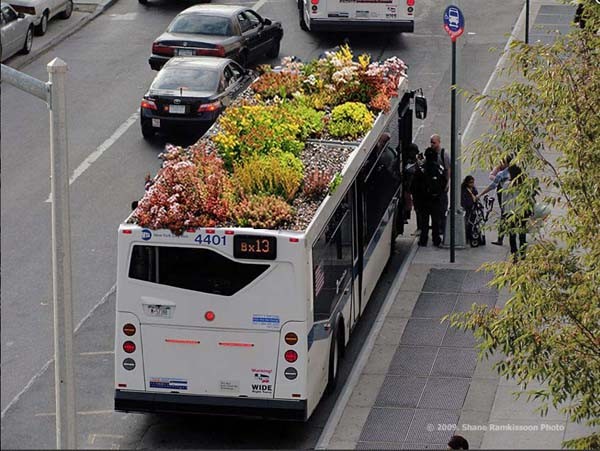living gardens on bus rooftops
Working in NYC everyday as I do understanding the value of parks and green spaces is obvious. But finding room for green spaces in more and more crowded cities isn’t easy. NYU graduate student Marco Castro Cosio has hit upon the idea of planting gardens on some previously wasted space found on city streets –  the roofs of buses. With New York’s Metropolitan Transportation Authority (MTA) running a fleet of around 4,500 buses, each with a surface area of 340 square feet (31.5 m2), Cosio says that if a garden was grown on the roof of every one, there would be an extra 35 acres of rolling green space in the city.
the roofs of buses. With New York’s Metropolitan Transportation Authority (MTA) running a fleet of around 4,500 buses, each with a surface area of 340 square feet (31.5 m2), Cosio says that if a garden was grown on the roof of every one, there would be an extra 35 acres of rolling green space in the city.
It might sound a bit far fetched but Cosio’s Bus Roots idea has managed to take second place in the DesignWala Grand Idea Competition and a prototype has already been installed on the roof of a vehicle dubbed the BioBus. The prototype garden only covers a small area at the rear of the BioBus’s roof and is mostly growing small succulents, but it has been traveling around New York for the last five months and has even ventured as far as Ohio.
Cosio says the purpose of the Bus Roots project is to reclaim forgotten space, increase the quality of life and grow the amount of green spaces in the city. Amongst the benefits of bringing plant life to the city listed by Cosio are mitigation of the urban heat island effect, acoustical and thermal insulation and CO2 absorption – although you’d have to wonder whether the amount of CO2 soaked up by the bus’s rooftop garden is enough to offset the extra fuel the bus will burn through carting the extra soil and plant life around.
If you’re interested in checking out the prototype BioBus, it will be open to the public at the Orpheum Children’s Science Museum in Urbana-Champaign, Illinois on Sunday, October 10 and at the USA Science & Engineering Festival at the National Mall in Washington D.C. from October 23–24.
